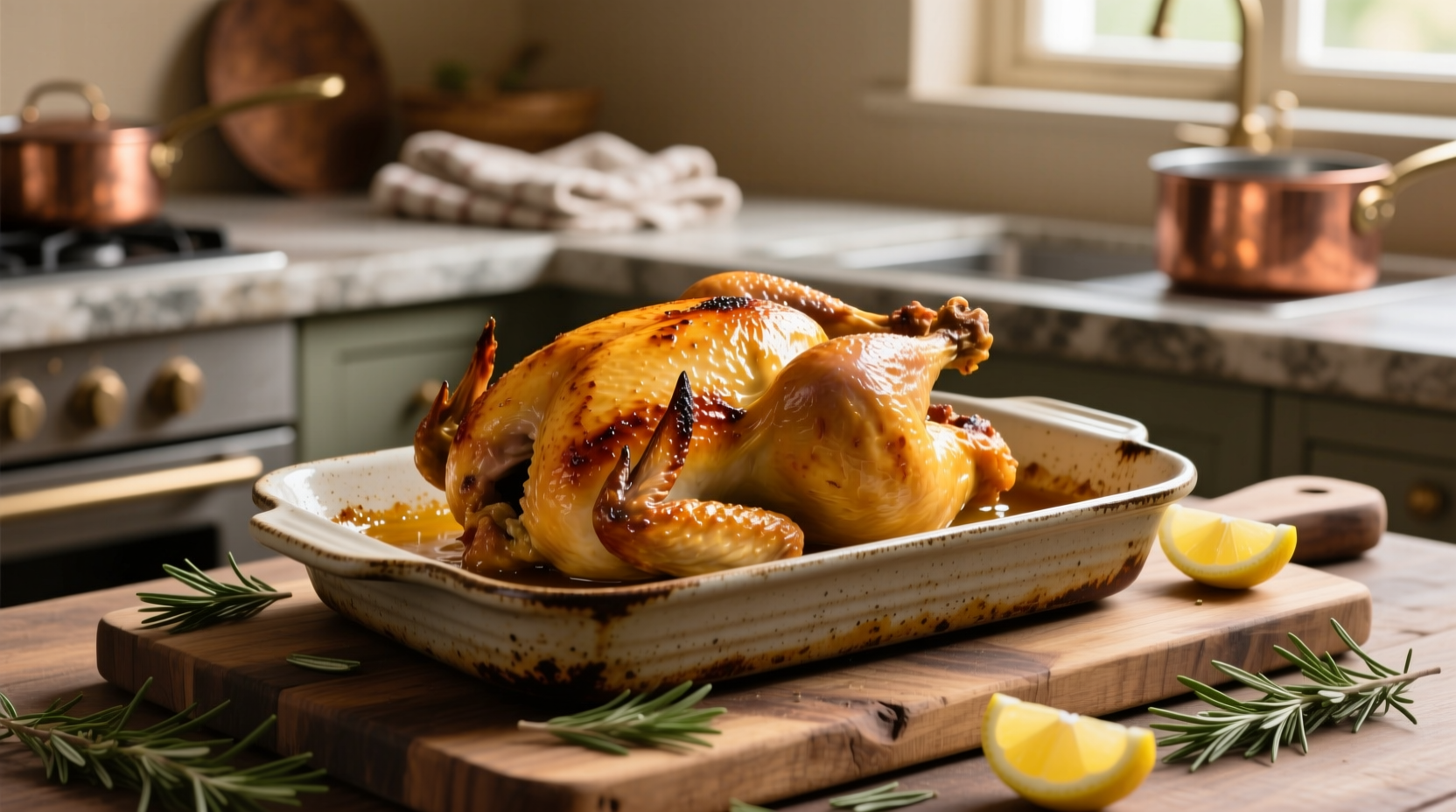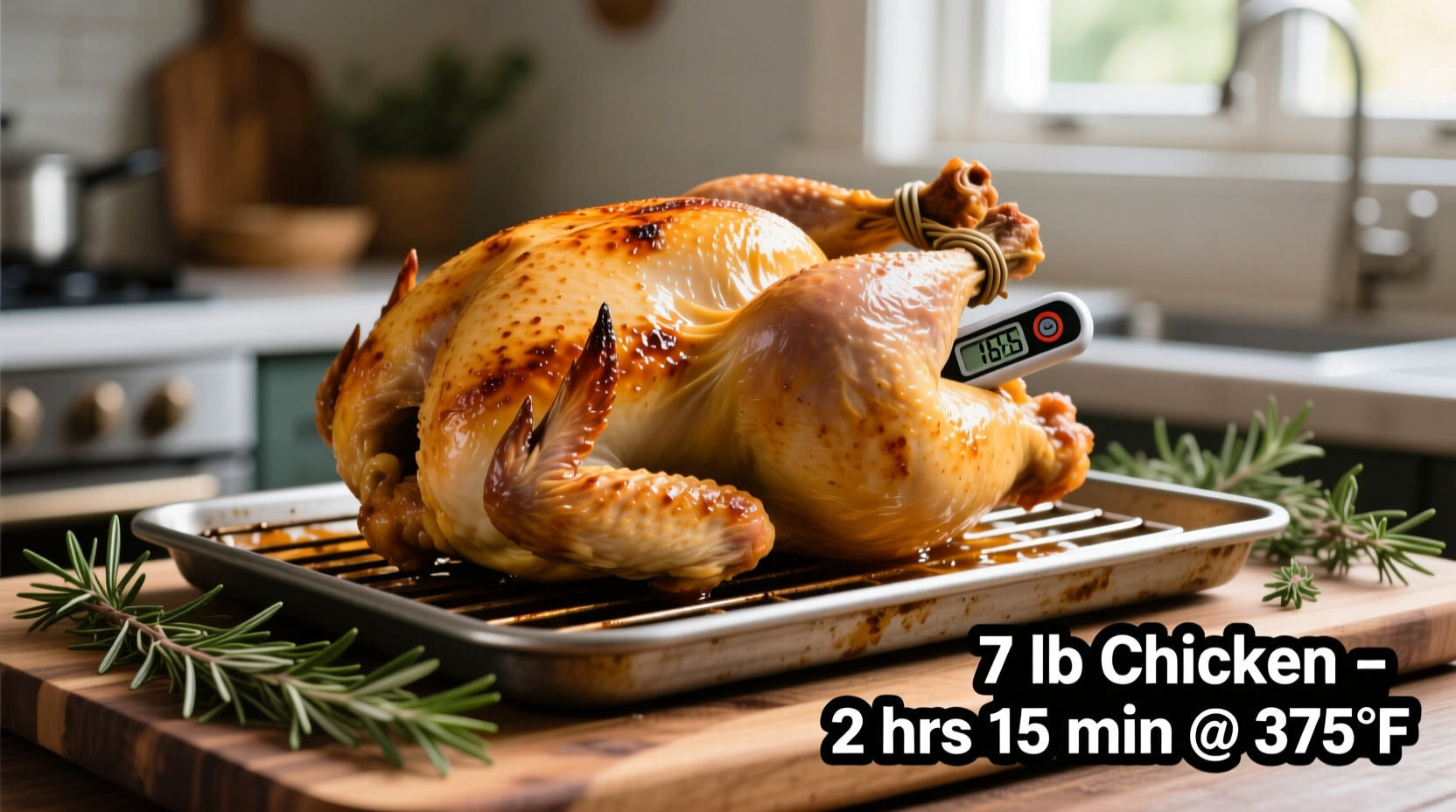For a 7 lb chicken roasted at 350°F (175°C), the perfect cooking time is 2 hours and 30 minutes to reach a safe internal temperature of 165°F (74°C) in the thickest parts. Always verify with a meat thermometer before serving.
Nothing beats the aroma of a perfectly roasted chicken filling your kitchen, but getting the timing right for a 7-pound bird can make or break your dinner. As someone who's cooked hundreds of chickens in professional kitchens and home ovens, I know exactly how nerve-wracking it can be to nail that perfect golden-brown exterior while ensuring the meat stays juicy and safe to eat. The good news? With the right timing and technique, you'll pull out a restaurant-quality roast chicken that impresses every time.
Why Precise Timing Matters for a 7-Pound Chicken
When you're working with a larger bird like a 7 lb chicken, timing becomes critical for both food safety and quality. Undercooked chicken poses serious health risks, while overcooked chicken turns dry and unappetizing. The USDA Food Safety and Inspection Service confirms that poultry must reach 165°F internally to eliminate harmful bacteria like salmonella. But hitting that temperature at just the right moment requires understanding how weight affects cooking duration.
The Standard Calculation Formula You Can Trust
Professional chefs and home cooks rely on a simple but reliable formula for roasting whole chickens:
- 20 minutes per pound at 350°F (175°C)
- Plus an additional 10-20 minutes
For your 7 lb chicken, this translates to:
7 lbs × 20 minutes = 140 minutes (2 hours 20 minutes) + 10-20 minutes = 2 hours 30-40 minutes total
This formula comes from the FDA Food Code guidelines that professional kitchens follow, adapted for home oven conditions. It accounts for the time needed for heat to penetrate the thickest parts of the bird while allowing for slight oven temperature variations.
Four Critical Factors That Change Your Cooking Time
While the standard formula gives you a solid starting point, these four variables significantly impact how long to cook your 7 lb chicken:
| Factor | Effect on Cooking Time | Adjustment Needed |
|---|---|---|
| Starting temperature (chilled vs room temp) | Cold chicken takes longer to cook | Add 15 minutes if starting chilled |
| Stuffing the cavity | Increases cooking time significantly | Add 30-45 minutes for stuffed chicken |
| Oven accuracy | Most home ovens vary by ±25°F | Use oven thermometer for accuracy |
| Rack position | Middle rack ensures even cooking | Lower rack = longer cooking time |
Your Step-by-Step Cooking Timeline for Perfect Results
Follow this precise timeline for a beautifully roasted 7 lb chicken:
- Prep (30 minutes before cooking): Remove chicken from refrigerator, pat dry, season, and let sit at room temperature
- Preheat oven: Set to 350°F (175°C) with rack in center position
- 0-60 minutes: Chicken begins browning, skin starts crisping
- 60-120 minutes: Internal temperature rises steadily through the "danger zone" (40°F-140°F)
- 120-150 minutes: Critical phase where you should start checking internal temperature
- 150 minutes: Check thickest parts (thigh and breast) with meat thermometer
- When reaching 160°F: Remove from oven (temperature will rise 5° during resting)
- Resting: 15-20 minutes before carving (essential for juicy meat)

How to Verify Doneness Beyond Just Timing
Timing alone isn't enough to guarantee a perfectly cooked chicken. Use these three verification methods together:
1. Internal Temperature Check (Most Reliable)
Insert an instant-read thermometer into the thickest parts:
- Thigh: 165°F (74°C)
- Breast: 165°F (74°C)
- Between leg and body: 165°F (74°C)
2. Juice Color Test
Pierce the thickest part of the thigh with a knife:
- Clear juices = properly cooked
- Pink or red juices = needs more time
3. Leg Movement Test
Gently wiggle the leg:
- Leg moves freely in socket = done
- Leg feels stiff = needs more time
Why Resting Time Is Non-Negotiable for Juicy Chicken
Many home cooks make the critical mistake of carving immediately after removing the chicken from the oven. For a 7 lb bird, 15-20 minutes of resting time is essential because:
- Temperature continues rising 5°F during resting (carryover cooking)
- Meat fibers relax, redistributing juices throughout the bird
- Carving too soon releases precious juices onto your cutting board
- Larger birds like 7 lb chickens need longer resting than smaller ones
Cover loosely with foil during resting, but don't wrap tightly as this can make the skin soggy.
Troubleshooting Common Chicken Roasting Issues
Brown Too Fast, Not Cooked Inside
If your chicken is browning too quickly but hasn't reached temperature:
- Reduce oven temperature to 325°F
- Create a foil tent over the breast area
- Move rack to lower position in oven
Dry Breast Meat, Undercooked Thighs
This common issue happens because breast meat cooks faster than dark meat:
- Start with breast-side down for first 30 minutes
- Use a meat thermometer to monitor both areas separately
- Remove breast portions early if using spatchcock method
Uneven Cooking
For consistent results with your 7 lb chicken:
- Rotate the pan 180 degrees halfway through cooking
- Use an oven thermometer to verify accurate temperature
- Ensure proper air circulation around the bird
Alternative Cooking Methods and Their Timing
While traditional roasting works best for most home cooks, these alternative methods change the timing significantly:
| Cooking Method | Temperature | 7 lb Chicken Time | Best For |
|---|---|---|---|
| Traditional Roasting | 350°F (175°C) | 2 hours 30 minutes | Classic golden-brown skin |
| High-Heat Roasting | 425°F (220°C) | 1 hour 45 minutes | Crispier skin, faster cooking |
| Slow Roasting | 300°F (150°C) | 3 hours 15 minutes | Extremely tender meat |
| Spatchcocked | 425°F (220°C) | 1 hour 15 minutes | Even cooking, no flipping |
Food Safety Reminders for Roasting Chicken
Following proper food safety practices is non-negotiable when cooking poultry:
- Never wash raw chicken (spreads bacteria)
- Use separate cutting boards for raw chicken
- Clean all surfaces that contact raw poultry
- Wash hands thoroughly after handling raw chicken
- Refrigerate leftovers within 2 hours of cooking
The USDA Food Safety and Inspection Service emphasizes that visual cues alone aren't sufficient to determine if chicken is safely cooked - always use a thermometer.
Pro Tips for the Best Roast Chicken Every Time
After years of refining my chicken roasting technique, here are my top professional tips:
- Dry brine overnight: Salt the chicken 12-24 hours before cooking for better seasoning and crispier skin
- Truss properly: Tuck wings and tie legs for even cooking
- Baste strategically: Only baste during the first hour to avoid temperature drops
- Use a roasting rack: Elevates chicken for even air circulation
- Add aromatics: Stuff cavity with lemon, garlic, and herbs for flavor infusion











 浙公网安备
33010002000092号
浙公网安备
33010002000092号 浙B2-20120091-4
浙B2-20120091-4